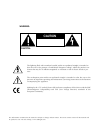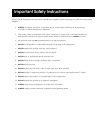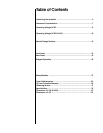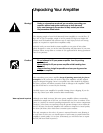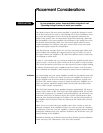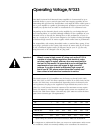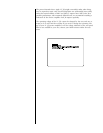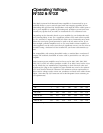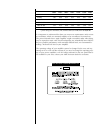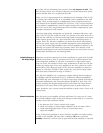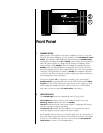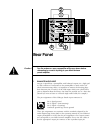
7
Placement Considerations
PRECAUTION
For your protection, review “Important Safety Instructions” and
“Operating Voltage” before you install your amplifier.
Your Mark Levinson 300-series power amplifier is specifically designed to stand
on the floor, and must be used as a freestanding unit. In most installations, locat-
ing it near the loudspeakers is best. Obviously, this approach minimizes the
length of the speaker wires and necessitates longer interconnecting cables from
the preamplifier to the power amplifier. The advantage to this strategy lies in the
fact that the interconnecting cables carry low-current signals which are more
readily transmitted over distances with great accuracy than are the necessarily
high current signals required by loudspeakers.
Note that adequate clearance for the AC cord and connecting signal cables must
be left behind your amplifier. We suggest leaving at least six inches (15 cm) of
free space behind your amplifier so all cables have sufficient room to bend with-
out crimping or undue strain.
If yours is a CE-certified unit (e.g., European market), the amplifier should also be
placed in such a way that the power switch on the rear panel is easily accessible.
This switch disconnects power from even the supervisory power supply, resulting
in effective disconnection of the amplifier from the AC mains. (Note that under
these conditions, the amplifier cannot respond to remote-turn-on commands, etc.)
Ventilation As a freestanding unit, your power amplifier normally has no problem with venti-
lation. Regardless of where you choose to locate your amplifier, we advise locat-
ing the amplifier well away from sensitive low-level components, typically near
the floor. (The massive output currents of which the 300-series amplifiers are ca-
pable can generate significant magnetic fields, which could conceivably induce
noise in some sensitive components.)
The Nº333 dual monaural power amplifier dissipates approximately 350 watts of
energy as heat when “at idle.” The Nº332 and Nº331 dissipate about 325 and 260
watts at idle, respectively. It is therefore normal and perfectly safe for them to run
somewhat warm. They do, however, require free air flow around them to allow
adequate heat dissipation through air circulation. The top plate and heatsinks of
the amplifier must be kept free from any obstruction that would reduce the free
flow of air.
Allow at least 4–6 inches above the amplifier and at least 2 inches to sides for
adequate ventilation. If the amplifier becomes too warm to touch, the ventilation
is inadequate. (Note that your new amplifier is protected against thermal damage.
Inadequate ventilation may cause nuisance shutdowns, but should not cause per-
manent damage to the amplifier.)
Mechanical drawings are included in this manual to facilitate special installations
where necessary (see “Dimensions” at the end of this manual).




